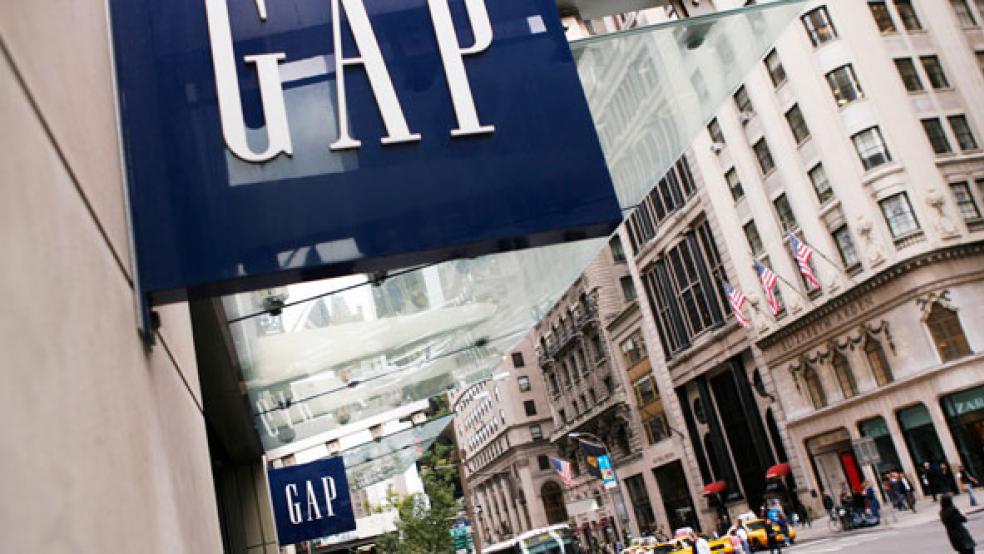Glenn Murphy, CEO of the Gap (GPS), might want to think about sending Mad Men creator Matthew Weiner a Jeroboam of champagne – or even commissioning a special vintage in his honor – as a vote of thanks. After all, the clothing retailer’s dramatic turnaround this year is due at least in part to the AMC television series, and in particular, the decision by Gap division Banana Republic to showcase Mad Men-themed styles (created with input from the show’s own costume designer) in its women’s retail stores, where avid consumers have snapped them up in hopes of emulating the on-screen flair of January Jones or Christina Hendricks.
That’s welcome news for Gap, which has been the laggard within the retail industry for longer than analysts or investors care to remember. Last November, when pre-holiday shopping was starting to pick up, the apparel companies tracked by Thomson Reuters as part of its retail universe reported a 4.4 percent increase in same-store sales for the month. Adding Gap’s plunging sales (same-store sales fell 5 percent that month) to the mix, and the group eked out a meager 1.4 percent advance. Flash forward four moths, however, and the picture looks dramatically different, says Thomson Reuters analyst Jharonne Martis. According to the firm’s same-store sales estimates, March 2012 will be the first month since December 2010 that the Gap will record a gain in sales at stores that have been open for at least 12 months.
RELATED: Walmart's $2 Billion Plan to Win Back Shoppers
Martis has witnessed the trend firsthand. Last week, she headed out to BabyGap to buy a gift for a friend’s newborn, and succeeded in snapping up the very last accessories in the 0-to-6-months size range in the store’s new infant line designed by Diane von Furstenberg. On the New York subway, she overheard a group of twenty-something women discussing their trip to the Gap to acquire pairs of the season’s must-own fashion item – jeans, in colors like “surf pipe blue,” “lemon drop” and “fuchsia” (as well as more ordinary colors like fire-engine red and vivid green). “They were talking about how hot and in style those pants were,” Martis says.
From brightly colored jeans at Gap stores to cigarette pants, cropped cardigans and sheath dresses at Banana Republic, Murphy’s team may finally have found a formula – other than frequent sales and hefty discounts – that will tempt shoppers to come back. The turnaround began in February, when Gap reported same-store sales rose 4 percent following a 4 percent slide in January; Banana Republic saw same-store sales gains double, to 12 percent from a 6 percent advance in January. In March, Martis expects the data to show that Gap recorded same-store sales gains of 5.4 percent, buoying the apparel group rather than being a drag on its results.
In response, analysts have started to upgrade their views on the formerly troubled retailer. Janney Capital Markets raised its rating on the stock from a hold to a buy; Bank of Montreal now views it as an “outperform” rather than a “market perform.” While the turnaround hasn’t yet shown up in Gap’s earnings (fourth quarter net income plunged 40 percent), analysts are cautiously revising their forecasts for the company’s 2012 profits higher.
RELATED: 5 Marketing Myths About Women
It’s still early in the turnaround, but it’s the first time in nearly a decade that fashionistas and investors seem to agree that Gap has found the right blend of style and business strategy. Most analysts still have a “hold” rating (or the equivalent) on the company, and it’s already trading above the median stock price target of $25 a share (the high end of the range is $35).
Some argue that at current valuations, it looks like a stock to shun or to sell – that the turnaround has been priced in. But there is plenty of room for the company to deliver a series of positive surprises on both same-store sales – due out in just a few days – and earnings, which the retailer expects to report in mid-May. That makes a great candidate to add to a portfolio as and when those more nervous investors edge back from a stock that has proved a chronic laggard in recent memory.






